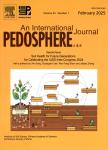Effects of Exogenous Nitric Oxide and 24-Epibrassinolide on the Physiological Characteristics of Peanut Seedlings Under Cadmium Stress
Effects of Exogenous Nitric Oxide and 24-Epibrassinolide on the Physiological Characteristics of Peanut Seedlings Under Cadmium Stress作者机构:College of Resources and Environment National Engineering Laboratory for Efficient Utilization of Soil and Fertilizer Shandong Agricultural University College of Agronomic Sciences Shandong Agricultural University
出 版 物:《Pedosphere》 (土壤圈(英文版))
年 卷 期:2019年第29卷第1期
页 面:45-59页
核心收录:
基 金:supported by Shandong Provincial Natural Science Foundation (No. R2017MD010) Shandong Province Higher Educational Science and Technology Program (No. J14LF08) Taishan Scholars at Seed Industry Talent Project- Shandong Province Seed Industry Project (No. 2014),China
主 题:antioxidant system cadmium toxicity cadmium translocation cadmium uptake heary metal mineral element sodium nitroprusside
摘 要:Cadmium(Cd) is highly toxic to plants, animals, and humans. Limited information is available on the role of nitric oxide(NO)and/or 24-epibrassinolide(EBR) in response of plants to Cd stress. In this study, a hydroponic experiment was performed to investigate the effects of NO and/or EBR on peanut plants subjected to Cd stress(200 μmol L^(-1)) with sodium nitroprusside(SNP, an exogenous NO donor)(250 μmol L^(-1)) and/or EBR(0.1 μmol L^(-1)) addition. The results showed that Cd exposure inhibited plant growth, and this stress was alleviated by exogenous NO or EBR, and especially the combination of the two. Treatment with Cd inhibited the growth of peanut seedlings, decreased chlorophyll content, and significantly increased the Cd concentration in plants. Furthermore, the concentration of reactive oxygen species(ROS) markedly increased in peanut seedlings under Cd stress, resulting in the accumulation of malondialdehyde(MDA) and proline in leaves and roots. Under Cd stress, applications of SNP, EBR, and especially the two in combination significantly reduced the translocation of Cd from roots to leaves, increased the chlorophyll content, decreased the concentrations of ROS, MDA, and proline, and significantly enhanced the activities of superoxide dismutase(SOD), peroxidase(POD), and catalase(CAT) in peanut seedlings. Exogenous NO and/or EBR also stimulated the activities of nitrate reductase(NR)and nitric oxide synthase(NOS) and increased the contents of antioxidants, such as ascorbic acid(AsA) and reduced glutathione(GSH). Furthermore, exogenous NO and/or EBR enhanced Cd accumulation in the cell wall and thus decreased Cd distribution in the organelles in the roots. The concentrations of calcium(Ca), iron(Fe), magnesium(Mg), and zinc(Zn) were also regulated by exogenous NO or EBR, and especially by the two in combination. These results indicated that SNP and EBR, alone and particularly in combination, can mitigate the negative effects of Cd stress in peanut plants.




